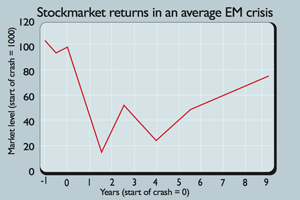Now is not the best time to buy Russia
Russia is on the verge of a full-on emerging-market crisis. Cris Sholto Heaton looks at similar past crises, and asks when should investors buy in.

As Russia's sell-off deepens, many investors are wondering whether it's time to buy into the market in the expectation of a quick profit when it recovers. Russian stocks already looked cheap, so by now they must be an absolute bargain. But if that's what you're thinking, make sure you understand the risks.
Russia is on the edge of a full-on emerging market crisis. And if that happens, valuation really doesn't matter. Instead, it's all about macroeconomics, politics and psychology and potentially a long wait for things to turn around.
To see what history tells us about buying into this kind of situation, we looked at what happened to stocks during a number of emerging-market crises over the last couple of decades (see below).
MoneyWeek
Subscribe to MoneyWeek today and get your first six magazine issues absolutely FREE

Sign up to Money Morning
Don't miss the latest investment and personal finances news, market analysis, plus money-saving tips with our free twice-daily newsletter
Don't miss the latest investment and personal finances news, market analysis, plus money-saving tips with our free twice-daily newsletter
While the details of these crises varied greatly, the outcome for markets was surprisingly consistent. If the past proves a good guide, there's a compelling case for staying away from Russian stocks for now.
How an EM crash plays out
The central bank tries to support the peg, by using its foreign exchange reserves to buy its own currency, or by putting up interest rates. This fails and the bank is forced to devalue or abandon the currency peg.
The devaluation hurts the economy (for example, companies with foreign currency borrowings can no longer afford to service them and default) and also inflicts large currency losses on foreign investors.The economy worsens, capital flight increases and markets plunge further.
In most of the major crises we looked at, the stockmarket began sliding several months before the currency peg was broken. The initial crash was an average of 84% in US dollar terms and took around one-and-a half years to reach the bottom (shorter in countries that abandoned currency pegs quickly and longer when the central bank fought to the end).

Frequently but not always they fell back to near or below the initial bottom (as the chart shows). This was normally more than four years into the crisis. In many cases, it still took a couple more years for a sustained stockmarket recovery to set in.
Why it pays to be patient
There was only one example of a crisis in the sample that did not fit this broad pattern at all: Argentina in 2002, when stocks began rallying as soon as the currency bottomed and never really saw that rally run out of steam.
This meant that investors did not need to time the bottom exactly to make good returns from these crises. A simple strategy of buying the market four years after the initial bottom was hit, actually delivered stronger average five-year returns from that point than the average five-year returns from buying at the bottom of the crisis exactly (217% versus 209%).
Given that the bottom is far easier to spot with a few years of hindsight, that suggests it's better to sit tight and wait for events to play out fully, than to try to time the turning point in the middle of a crisis.
The typical pattern of an emerging-market crisis
For more recent crises, it's hard to separate the impact of the global financial crisis and eurozone crisis from what happened within individual emerging markets.
However, Vietnam (2007), Nigeria (2008) and Pakistan (2008) were all examples of stock and currency crashes where domestic issues (such as a banking crisis or a balance of payments crisis) clearly played a key role.
All three seem to be fitting the pattern well, although Pakistan has recovered unusually strongly. Hungary (2008), Ukraine (2008) and the peripheral eurozone economies (2010 onwards) also appear to be following the same trend, although it's not clear whether these crises are over.
| Crash | -84% | -62% | -93% | 1.5 years |
| Rally | 233% | 93% | 630% | 1.2 years |
| Sell-off | -55% | -44% | -76% | 1.8 years |
Get the latest financial news, insights and expert analysis from our award-winning MoneyWeek team, to help you understand what really matters when it comes to your finances.
Cris Sholto Heaton is an investment analyst and writer who has been contributing to MoneyWeek since 2006 and was managing editor of the magazine between 2016 and 2018. He is especially interested in international investing, believing many investors still focus too much on their home markets and that it pays to take advantage of all the opportunities the world offers. He often writes about Asian equities, international income and global asset allocation.
Cris began his career in financial services consultancy at PwC and Lane Clark & Peacock, before an abrupt change of direction into oil, gas and energy at Petroleum Economist and Platts and subsequently into investment research and writing. In addition to his articles for MoneyWeek, he also works with a number of asset managers, consultancies and financial information providers.
He holds the Chartered Financial Analyst designation and the Investment Management Certificate, as well as degrees in finance and mathematics. He has also studied acting, film-making and photography, and strongly suspects that an awareness of what makes a compelling story is just as important for understanding markets as any amount of qualifications.
-
 The best UK Christmas markets for a wassail of a time
The best UK Christmas markets for a wassail of a timeWe round up the best UK Christmas markets to visit, from London's Hyde Park Winter Wonderland to Edinburgh's Princes Street Gardens
-
 Autumn Budget tax changes: how is your generation affected?
Autumn Budget tax changes: how is your generation affected?The chancellor expects everyone to do their bit to boost the nation's finances but the tax burden is by no means shared equally
